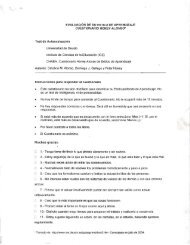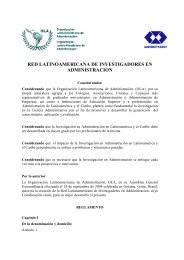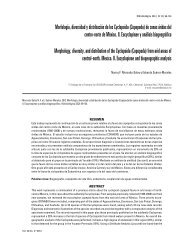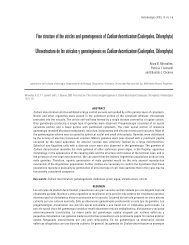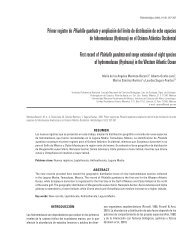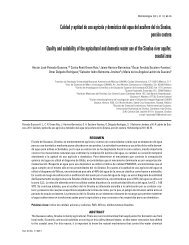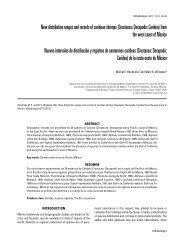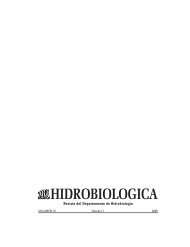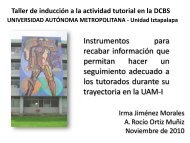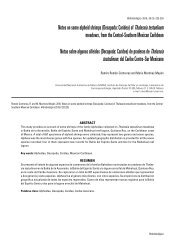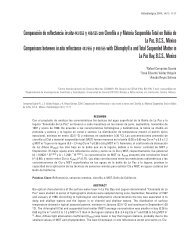Manglares - Páginas de Investigación, UAM Iztapalapa
Manglares - Páginas de Investigación, UAM Iztapalapa
Manglares - Páginas de Investigación, UAM Iztapalapa
- No tags were found...
Create successful ePaper yourself
Turn your PDF publications into a flip-book with our unique Google optimized e-Paper software.
<strong>de</strong> la última glaciación. Para ello se muestrearon turberas <strong>de</strong> un manglar enano en unabahía interna <strong>de</strong> la costa Nor-oriental <strong>de</strong> Puerto Rico. Se hizo un transecto en el áreacentral <strong>de</strong>l manglar y se muestreó la turba con un muestreador Hyller en su parte másprofunda cada 10cm hasta llegar a suelo marino (4.5m). Se <strong>de</strong>terminó edad <strong>de</strong> la turbapor 14C y origen <strong>de</strong>l sustrato mediante abundancia natural <strong>de</strong> 13C y 15N. Losresultados muestran que: 1) ha habido <strong>de</strong>posición <strong>de</strong> turba en los últimos 3500 añoscuando la tasa <strong>de</strong> subida <strong>de</strong>l nivel <strong>de</strong>l mar se estabilizó en el Caribe 2) que esta turbaproviene <strong>de</strong> <strong>de</strong>scomposición <strong>de</strong>l manglar, 3) el clima <strong>de</strong>s<strong>de</strong> el origen <strong>de</strong>l manglar no hasido uniforme e incluso está bastante relacionado con las épocas secas y húmedas <strong>de</strong>s<strong>de</strong>su comienzo.EXAMINING EFFECTS OF THE 2005 HURRICANES ON THE LAND-OCEANCONTINUUM IN THE YUCATAN PENINSULA USING REMOTE SENSING.Eurico D’Sa*, Víctor H. Rivera-Monroy and Nazanin Chaichi-Tehrani.*ejdsa@lsu.eduIn 2005, Hurricanes Emily, Stan and Wilma ma<strong>de</strong> landfall along the YucatanPeninsula (YP) impacting both coastal ecosystems and interior regions of the coast. Westudy the effects of these hurricanes on the land-ocean continuum by examining changesin coastal vegetation, including mangroves, and primary productivity of coastal watersusing remote sensing data, namely enhanced vegetation in<strong>de</strong>x (EVI), chlorophyll andsea surface temperature (SST) from SeaWiFS and MODIS sensors. Hurricane Emilyma<strong>de</strong> landfall at Cozumel and Playa <strong>de</strong>l Carmen on 18 July as a strong Category 4hurricane and weakened as it crossed the YP. Tropical storm Stan ma<strong>de</strong> landfall on 2October south of Tulum and weakened to a <strong>de</strong>pression as it crossed the peninsula.Hurricane Wilma ma<strong>de</strong> landfall on 21 October in the northeastern YP as a powerfulCategory 4 hurricane emerging and moving northeastward in the Gulf of Mexico as aCategory 2 hurricane. EVI change imagery examined pre- and post-hurricanes betweentwo adjacent years indicated most damage to coastal and inland vegetation fromHurricane Wilma, followed by Emily and least by Stan. SST imagery before andfollowing the hurricane passages indicated variable extent of upper ocean cooling.Satellite data generally indicated elevated levels of chlorophyll concentrations alongcoastal waters of northern and eastern YP. The offshore extent of elevated chlorophyllconcentrations increased following the passage of the three hurricanes. Hurricanes131



